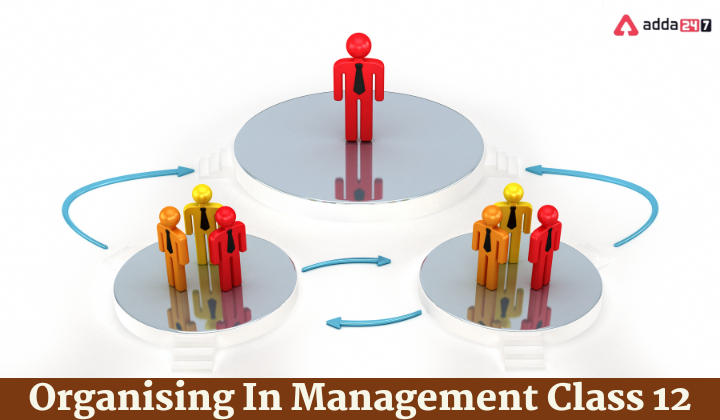Table of Contents
Organising- Definition in Management for Class 12
One of the most crucial managerial tasks is organisation. It is a relationship created between people, work, and resources in an organisation that is used to accomplish the common objectives or aims of the organisation as a whole, according to business and management jargon. We will provide you with crucial study notes on one of the chapters of Business Studies Organizing Class 12 in this blog post on organising class 12 notes. If you want to learn more about organising class 12 notes, read this blog post through to the conclusion because it is a crucial component of the commerce subjects.
Organising- Meaning
Let’s define organising so we can proceed with this blog post about class 12 note organisation. Identifying and classifying various organisational operations is the responsibility of the business management function known as organising. In addition, it deals with assembling the established and necessary material, financial, and human resources to accomplish organisational objectives. To organise a firm, according to Fayol, is to give it all the resources necessary to operate, including raw materials, equipment, capital, and employees.
Organising- Function of Management
Maximum Resource Utilisation: Appropriate work distribution avoids job duplication and overlap, which reduces the wastage of time, money, and resources.
Adaptation To Change: A well-designed organisational structure that is flexible and makes it easier to react to variations in workload brought on by changes in the external environment caused by technology, goods, resources, and market conditions is enabled by organising.
Benefits Of Specialisation: Specialisation is encouraged since each employee is only given a fraction of the overall work and not the complete job or assignment. The separation of labour into smaller units and repetitive output also help specialisation. Specialisation, therefore, results in effective and quick task efficiency.
Personnel Development: On the side of the workforce, the efficient organisation fosters initiative and contextual thinking. When managers transfer their authority to focus on more crucial growth & innovation concerns, it lessens their workload.
Expansion And Growth: Effective organisation helps a firm expand and diversify by creating more positions, departments, line managers, product lines, new geographic regions, etc.
Ace your preparation level with CLAT 2023 preparation batch.
Organising Process
Identification & Work Division:
Divide the whole labour into distinct jobs in accordance with preset arrangements. –
A job is a group of connected duties that one person can complete. It should have clear and precise tasks that must be completed. It should specify expected results along with the job as much as possible.
– Division of labour results in the specialization of efforts and abilities + prevents task duplication.
– Management is responsible for ensuring that all the tasks necessary to accomplish organisational goals have been defined.
Departmentalization:
– Combining related jobs into departments, divisions, or sections, which are then supervised by a department head. It makes specialisation easier.
– The divisions are interconnected and rely on one another.
– Strives for coordination and makes motion more cohesive. Departmentalization may be done in accordance with:
- Functions include marketing, hiring, and financing.
- Products: chemicals, power division, textiles, etc.
- Territories include those in the West, North, Center, and East.
Assigning Duties:
– Specify the responsibilities of various job positions and distribute work accordingly.
– After departments are established, that person is given control over that department.
– The person most suited to do a task is given the job.
– Duties should be aligned with people’s abilities, aptitudes, experience, and qualifications.
– For instance, financial tasks should be delegated to those with the necessary training and experience, such as C.A‘s.
Establishing Relationships for Reporting:
– Giving staff the necessary power so they can do their jobs well.
– The creation of superior-subordinate relationships between various persons and occupations so that everyone is aware of who can give them commands and from whom they should accept them.
– Establishes a management hierarchy, which is a chain of command starting with the top manager and ending with the lowest level employee.
– The coordination is aided by this.
Organisational Structure
Moving on with our blog post on class 12 notes organisation, let’s now examine what an organisational structure is. The organisational structure, to put it simply, is a structure that shows and explains the interaction between all the people and departments employed by the organisation. Therefore, this structure offers a foundation of the framework for the top management, line managers, and other staff to accomplish their necessary and required responsibilities. It can also be described as the framework for carrying out operational and managerial responsibilities.
Types Of Organisational Structure
There are 2 different sorts of organisational structures, specifically:
Functional Structure: In this structure, the activities, jobs, or tasks are grouped according to how each one performs its specific function.
| Advantages | Disadvantages | Suitability |
|
make any one department accountable.
|
The functional organisational structure
is most suitable if and when the size of the organisation is large and has diversified activities or operations and hence need or require a high degree of specialisation. |
Divisional structure: In accordance with the organisational structure described in our class 12 notes on organising, when a company produces more than one product and is big or large, the activities related to product A are grouped together or combined under one department, and the same is true for the other products.
| Advantages | Disadvantages | Suitability |
|
|
|
Formal And Informal Organisation
Formal Organisation:- In a formal organisation, an organisational structure is established as the management carry out the organizing process in order to provide organised working conditions and effective resource use.
Informal Organisation:- The organisational structure of an informal organisation, on the other hand, is essentially a network of social and personal connections that are not created by the official organisation.
Difference Between Formal & Informal Organisation
| BASIS | Formal organisation | Informal organisation |
| Formation | deliberately planned and created by management | Emerges spontaneously as a result of social interaction among people. |
| Purpose | To achieve planned organizational goals | To satisfy social & cultural needs. |
| Communication | Formally establishes official lines of communication | Informal communication based on convenience. |
| Leadership | Managers are leaders by virtue of their superior positions | Leaders are chosen. |
| Stability | It is stable and predictable | Neither stable nor predictable. |
Get your CUET preparation done with Adda247 online classes new CUET 2023 batch.
Organising In Management Class 12 Important Questions
Ques 1. Explain
(i) expansion, development, and
(ii) The importance of organising is to use resources as efficiently as possible.
Ans. (i) Expansion and growth Organization enables an organisation to diverge from established conventions and take on new challenges, which aids in its growth and diversification. In other words, an effective organisation boosts an organisation’s potential to take on more tasks while also assisting in keeping the numerous operations under control.
(ii) Optimal resource utilisation Organizing enables the efficient use of all material, financial, and human resources. The most effective use of resources is made possible by the right job assignment, which also prevents work from overlapping. Reducing confusion and effort and resource waste is made possible by avoiding duplication of effort.
Ques 2. Describe how managerial functions include “organising.”
Ans. Organizing is a managerial function that builds productive relationships between the people, financial, and physical resources in order to achieve particular objectives.
Ques 3. Give any two justifications for why organising is seen as a crucial management function.
Ans. The vital significance that organisation plays in any corporate venture is highlighted by the following points:
(i) Clarity in working connections: The development of working relationships establishes “who will report to whom” and clarifies the channels of communication. This clears up any ambiguity in the transmission of knowledge and instructions.
(ii) Effective administration: Organized management Jobs and associated responsibilities are clearly described through organising. By doing so, confusion and duplication are reduced. Effective work execution is made possible by clear working relationships. As a result, managing an enterprise becomes simple, which improves administration.
Ques 4. Definition of Organising
Ans. According to Henry Fayol, ‘To organise a business means to provide it everything useful to its functioning, viz raw material, tools, capital and personnel’.
Ques 5. What kind of “organisational structure” encourages effective labour utilisation?
Ans. An organisational structure known as a functional structure encourages effective labour usage.
Ques 6. Companies with multiple goods, each with unique attributes, are better suited for divisional structures. Do you concur?
Ans: Yes, I do agree. Organizations with multiple products, each with unique qualities, or those with broad geographic coverage or separate market sectors might consider using a divisional structure. The organisation can benefit from functional structure by being divided into a number of independent divisions.
Ques 7. What distinguishes a functional structure from a divisional structure?
Ans. The distinction between a divisional organisation and a functional structure is highlighted by the following points.
| Basis | Functional Structure | Divisional Structure. |
| Formation | It is based on functions | It is based on product lines |
| Specialisation | Functional Specialisation | Product Specialisation |
| Responsibility | Difficult to fix on a
departments |
Easy to fix responsibility |
| Cost | Economical | Costly |
| Co ordination | Difficult for multi product
company |
Easy, because all functions related
to a particular product are integrated in one department. |
| Managerial
Development |
Difficult, as each functional
manager has to report to the top management |
Easier, autonomy as well as the
chance to perform multiple functions helps in managerial development. |
Ques 8. List any three advantages of a formal organisation.
Ans. Benefits of a formal organisation include:
- Due to the well defined mutual ties or associations, fixing accountability is always simpler.
- Through an established chain of command, it preserves the unity of command.
- Because there are specific rules to direct employee behaviour, it gives the establishment stability.
Ques 9. Include the components of delegation.
Ans. The delegation’s three basic components are as follows:
Responsibility: Responsibility refers to a subordinate’s commitment and accountability to finish the assigned duty.
Authority: The ability granted to a person to direct and instruct others is referred to as authority.
Accountability: Accountability refers to the superior’s responsibility for the results of the task that he or she has completed.
Ques 10. Do you agree with the manager’s perspective that he is not accountable for the calibre of the task that he has assigned to his subordinate? Justify your response with the appropriate agreements.
Ans: The statement is false since the absoluteness of accountability principle was broken in this instance. The individual delegating authority is still responsible to his or her own employer for the work that has been assigned to the subordinate. In a nutshell, the practise of delegating authority does not absolve the manager of personal responsibility.
Organising (आयोजन) in Hindi
सबसे महत्वपूर्ण प्रबंधकीय कार्यों में से एक संगठन है। यह एक संगठन में लोगों, काम और संसाधनों के बीच बनाया गया एक संबंध है जिसका उपयोग व्यवसाय और प्रबंधन शब्दजाल के अनुसार संगठन के सामान्य उद्देश्यों या उद्देश्यों को पूरा करने के लिए किया जाता है। हम आपको इस ब्लॉग पोस्ट में कक्षा 12 के नोट्स के आयोजन पर बिजनेस स्टडीज ऑर्गेनाइजिंग क्लास 12 के अध्यायों में से एक पर महत्वपूर्ण अध्ययन नोट्स प्रदान करेंगे। यदि आप कक्षा 12 के नोट्स के आयोजन के बारे में अधिक जानना चाहते हैं, तो इस ब्लॉग पोस्ट को अंत तक पढ़ें क्योंकि यह वाणिज्य विषयों का एक महत्वपूर्ण घटक है।
आयोजन – अर्थ
आइए आयोजन को परिभाषित करें ताकि हम कक्षा 12 के नोट संगठन के बारे में इस ब्लॉग पोस्ट के साथ आगे बढ़ सकें। विभिन्न संगठनात्मक कार्यों को पहचानना और वर्गीकृत करना व्यवसाय प्रबंधन कार्य की जिम्मेदारी है जिसे आयोजन के रूप में जाना जाता है। इसके अलावा, यह संगठनात्मक उद्देश्यों को पूरा करने के लिए स्थापित और आवश्यक सामग्री, वित्तीय और मानव संसाधनों को इकट्ठा करने से संबंधित है। फेयोल के अनुसार, फर्म को संगठित करने का अर्थ है उसे संचालन के लिए आवश्यक सभी संसाधन देना, जिसमें कच्चा माल, उपकरण, पूंजी और कर्मचारी शामिल हैं।
आयोजन- प्रबंधन का कार्य
अधिकतम संसाधन उपयोग: उपयुक्त कार्य वितरण नौकरी के दोहराव और ओवरलैप से बचा जाता है, जिससे समय, धन और संसाधनों की बर्बादी कम होती है।
परिवर्तन के लिए अनुकूलन: एक अच्छी तरह से डिज़ाइन किया गया संगठनात्मक ढांचा जो लचीला है और प्रौद्योगिकी, वस्तुओं, संसाधनों और बाजार की स्थितियों के कारण बाहरी वातावरण में बदलाव के कारण आने वाले कार्यभार में भिन्नता पर प्रतिक्रिया करना आसान बनाता है, को व्यवस्थित करके सक्षम किया जाता है।
विशेषज्ञता के लाभ: विशेषज्ञता को प्रोत्साहित किया जाता है क्योंकि प्रत्येक कर्मचारी को समग्र कार्य का केवल एक अंश दिया जाता है, न कि पूर्ण कार्य या असाइनमेंट। श्रम को छोटी इकाइयों में अलग करना और दोहरावदार उत्पादन भी विशेषज्ञता में मदद करता है। विशेषज्ञता, इसलिए, प्रभावी और त्वरित कार्य दक्षता में परिणाम देती है।
कार्मिक विकास: कार्यबल के पक्ष में, कुशल संगठन पहल और प्रासंगिक सोच को बढ़ावा देता है। जब प्रबंधक अधिक महत्वपूर्ण विकास और नवाचार संबंधी चिंताओं पर ध्यान केंद्रित करने के लिए अपना अधिकार हस्तांतरित करते हैं, तो यह उनके कार्यभार को कम करता है।
विस्तार और विकास: प्रभावी संगठन अधिक पदों, विभागों, लाइन प्रबंधकों, उत्पाद लाइनों, नए भौगोलिक क्षेत्रों आदि का निर्माण करके एक फर्म के विस्तार और विविधता में मदद करता है।
Organising- FAQs
Ques 1. Why is organising deemed to be a crucial managerial function?
Ans. Every person in the organisation has a successful role-job match thanks to organising. It aids in reducing confusion, delays, double work, and effort overlap.
Ques 2. What does the organisation want to accomplish?
Ans. The driving force directing, leading, and bringing an organisation to a perceived objective is its organisational purpose.
Ques 3. What does the organisation want to accomplish?
Ans. The driving force directing, leading, and bringing an organisation to a perceived objective is its organisational purpose.
Ques 4. Are managers at all levels of management required to organise?
Ans. It establishes distinct relationships between jobs and ensures inter-personal cooperation.
Ques 5. Which type of organisational structure is most prevalent?
Ans. The most typical organisational structure used by businesses is the functional organisational structure. This well-liked concept divides employees into teams and departments according to their respective job duties.



 NEET UG 2025: Is NEET Previous years Que...
NEET UG 2025: Is NEET Previous years Que...
 JEE Mains Session 2 Result 2025 OUT, Sco...
JEE Mains Session 2 Result 2025 OUT, Sco...
 TS Inter Results 2025 Date for TSBIE 1st...
TS Inter Results 2025 Date for TSBIE 1st...








